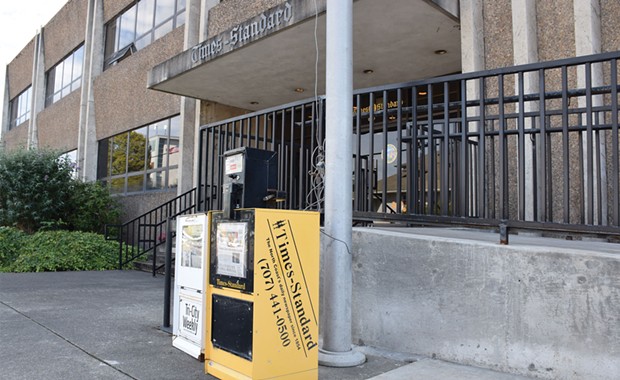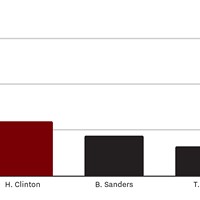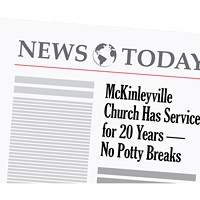'Insurmountable'
Humboldt's 'old-growth' daily newspaper slammed by another round of cuts
By Thadeus Greenson [email protected] @ThadeusGreenson[
{
"name": "Top Stories Video Pair",
"insertPoint": "7",
"component": "17087298",
"parentWrapperClass": "fdn-ads-inline-content-block",
"requiredCountToDisplay": "1"
}
]
When Daniel Squier returned to the Times-Standard in January of 2018 to take a reporting job covering local courts, he knew he would be stepping into a newsroom fundamentally changed from the one he left 12 years earlier. When Squier served as the paper's sports editor in the early 2000s, he was one of four people on the sports desk, which sat between the reporters, seven of them in all, and the photo department, which had three full-time employees. The newsroom he was returning to had nine employees total.
But Squier also saw the Times-Standard as a local institution, not unlike the old growth redwoods that still tower over parts of the North Coast. The paper had been publishing in its current form as the Times-Standard for 50 years but its roots stretched back further, to the Humboldt Times and the Humboldt Standard, which began publishing in 1854 and 1875, respectively, and battled for headlines for much of the next century until merging in 1967. In one form or another, the Times-Standard has been Humboldt County's daily paper of record for 150 years, chronicling its tragedies and celebrations, its failures and its successes.
By last year, however, the paper had been cut to the bone, largely the result of corporate decisions made hundreds of miles away. Many thought there was simply no way the newsroom could sustain further cuts and continue to cover a county with seven city councils, more than half a dozen police agencies, 30 school districts, two courthouses and a multitude of community services districts. They were wrong. In a roughly six-week span from late July to early September, recently hired Publisher John Richmond let three newsroom employees go, Squier and the sole staff photographer among them, freezing their positions and reducing the newsroom staff by 33 percent.
"This is corporate greed destroying a local institution," Squier says.
There are plenty who believe Squier isn't wrong and would say the Times-Standard is simply a small example of a pattern playing out across the United States as the newspaper's owners gut their properties to maximize profits.
Locally owned until 1967, the Times-Standard then passed through the hands of a couple chains until landing in the hands of MediaNews Group (MNG) in 1996. The Denver, Colorado-based company — a controversial one in newspaper circles that was later rebranded as Digital First Media — was founded by Richard Scudder and William Dean Singleton, and grew to become one of the largest newspaper companies in the country, operating 56 dailies across 12 states with a combined circulation of more than 2 million. While Singleton was notorious for pinching pennies and a thirst for acquisitions, he'd also broken into the industry as a reporter at the age of 15 and had an appreciation for newspapers and the roles they play in their communities.
"Dean Singleton cared about his newspapers," says David Little, who served as the Times-Standard's managing editor from March of 1998 until he left in June of the following year to take the same job at another MNG paper, the Chico Enterprise Record in his hometown, at which his great grandfather, grandfather and father had all worked. "He would fly to Eureka once a year to visit the paper, visit the newsroom and talk to the reporters face to face."
But in August of 2006, Singleton took a large gamble, taking $350 million in loans to purchase four newspapers from the McClatchy Company. It's hard to imagine the purchase coming at a worse time, just as online classified services like Craigslist were growing to cut into one of print media's largest revenue sources and just two years before the mortgage crisis caused a national recession. Ultimately, MNG would file for bankruptcy protection and emerge in 2010 under the majority owner of its lenders, most notably Alden Global Capital, a hedge fund based in New York City.
Media experts have described Alden's reign as a newspaper owner as ruthless and some reports indicate the company has slashed 66 percent of staff at its media properties since taking them over. And because Alden Global Capital is privately held with its properties spread through sordid layers of LLCs, it's hard to trace profits and losses, and harder still to know who's making the decisions.
But the hedge fund has faced no small amount of industry backlash for its cost cutting. Most notably, the Denver Post, once MNG's flagship paper, mounted an insurrection last year, reporting that Alden had cut its staff by about 70 percent since taking ownership and calling for someone to buy out the firm, which it referred to as "vulture capitalists" in an editorial.
And while Singleton, for his arguable faults, saw newspapers primarily as vehicles for information, Alden clearly sees them as just one part of an investment portfolio designed to return profits to shareholders. According to an article in The Nation, which scoured court records in a Delaware lawsuit involving the company, Alden "bled at least $241 million in cash — plus many millions more in real estate" from its media properties, "borrowed" $248.5 million form their workers' pension and used them to take on $200 million in debt to finance other investments.
It's proven a profitable strategy, as the New York Post reported that Alden's media holdings turned a profit of $160 million in 2018, prompting Niemen Lab columnist Ken Doctor to quip, "Alden Global Capital is making so much money wrecking local journalism it might not want to stop anytime soon."
In Eureka, where the Times-Standard had staffed up considerably in the midst of one of the nation's last true newspaper wars, competing for sole ownership of the daily market share against local businessman Rob Arkley's free Eureka Reporter, which shuttered in 2008, the bloodletting has been relentlessly consistent.
Journal assistant editor Kimberly Wear served as the Times-Standard's managing editor from 2008 through 2016 and took over a newsroom of 26 full-time employees (this reporter among them), not including part-timers and freelancers. When she left to take a position at the Journal, there were 13.
"The pace quickened," Wear says of the cutting after Alden took over. "If somebody left, you had to beg and fight to get that position refilled. You'd have to hire people low (on the salary scale) and couldn't give raises, so people cycled out. You were losing your veterans and getting inexperienced, new reporters in return. They weren't rooted to the area, so they looked to leave as soon as they could. When they did, you'd have to fight to justify their position. It just felt like every position became a battle. It started to feel like it was so insurmountable."
Wear says there were certain one-size-fits-all corporate solutions that caused headaches, too, including a seemingly endless wave of required reports and tallies aimed at quantifying the paper's output. She points to the elimination of the Times-Standard's layout desk as another example. Back in 2015, Alden decided to consolidate the layout of its newspapers into regional hubs as a cost-cutting move. The idea is to have a room full of designers who can work remotely to lay out more than a dozen newspapers. But Wear says the savings for the Times-Standard were negligible — if there were any at all — as the paper had to pay for the hub's services and still have a one-person night desk to coordinate with the hub about paper layout.
And the thing was a massive headache, as it pushed the paper's print deadlines up considerably, making it challenging to cover late city council meetings and all but impossible to get a paper out after Election Day with final results. It also introduced inefficiencies, forcing editors to sit around waiting, sometimes for hours, for the hub to get them final pages to approve. And it took away valued sets of proofing eyes and live bodies who could run out of the newsroom to respond to an emergency or late breaking story.
"We just lost a lot of control," Wear says, adding that sometimes resulted in near misses, like when an out-of-area editor shortened "Southern Humboldt" to "South Humboldt" in a headline before it was caught.
Little says staff reductions played out similarly in Chico, noting that while he doesn't recall ever having to lay someone off, vacant positions would become frozen to the point that he was losing two or three people a year in what he described as "death by a thousand cuts."
And when positions were cut, Wear and Little say there was never any retooling of expectations of what the papers would cover.
"That was the hardest part to me," Little says, adding that almost to a fault, newsroom employees would do everything they could to pick up the slack. "When something like the Camp Fire hits, or the Lake Oroville spillway is crumbling, the community doesn't care how many reporters you have. They want the news and they deserve the news. The hard part isn't so much covering the news. We always find a way to cover the news. The hard part is telling worthy people, 'Sorry, no raise and you're going to have to take one third of the workload of the position we just cut.'"
Right now, the six people in the Times-Standard newsroom are trying to suck it up and pick up the slack, figuring how six people can put out a daily paper that reflects the people and news of a sprawling county like Humboldt. And they're doing it seemingly with little hope of reinforcements showing up to help.
Richmond, who left a role as general manager at Lost Coast Communications earlier this year to take over as publisher of the Times-Standard, penned a column Sept. 11 addressing changes at the daily.
"The mission is simple and it's the same (or should be) for every member of the Fourth Estate: to inform, educate, entertain and reflect Humboldt County with the best journalism possible," he wrote. "To that end I issue the following statement: The Times-Standard is doing just fine."
The column goes on to note recent layoffs, saying the paper — like any business — has "to operate to a model of profit and loss." He goes on to outline his plans, which include pressing reporters to keep stories shorter while writing more of them, post press releases online faster, get community leaders — like elected officials and the "chambers of commerce" — to contribute content and increase communication with the public.
Richmond declined to be interviewed for this story. When contacted, he asked that the Journal provide him a copy of the story in advance of publication so he could craft an official statement. When we declined, as our policy — standard across the industry — is not to give sources copies of stories before they are published, and instead offered him a summary of what the story would cover, he opted not to send the statement and instead referred us to his Sept. 11 publisher's column.
Squier says Richmond has pushed internally for reporters to sharpen their headlines and social media efforts to drive online traffic, which has greatly frustrated staff, who believe the largest barrier to web traffic is not the paper's content but the fact that it is hidden behind a paywall, arguably putting it at a distinct disadvantage against its local competitors. Squier says that when pressed by staff to answer whether revenue generated by the paywall justifies the hit it causes in online traffic (not to mention community frustration), Richmond said that was "private financial information."
Morale at the paper tanked after Shaun Walker, the longtime photographer, was let go in late July, Squier says, adding that the "anger was palpable." When Rob Peach, who'd taken a job as the paper's one-man night desk months earlier, was let go, things went further south. And the thing that angers Squier most is that he feels the paper was doing good work with a skeletal crew that was dedicated to the community.
"This is corporate greed and it's destroying the literal old growth news source of Humboldt County so some fucking hedge fund can add another $1,000 to its spreadsheet," he says.
Adding a certain sting to the layoffs, newsroom staff was reportedly told that at least some of the reasons for the cost cutting measures weren't local: They say there was a Redding car dealership that pulled its ads and the Chico Enterprise Record mounted massive overtime expenses during its coverage of the devastating Camp Fire, which earned a nod as Pulitzer Prize finalist.
Little, who retired late last year and now serves as the faculty advisor for Chico State University's student newspaper and the executive vice president of a foundation overseeing the disbursement of donations for Camp Fire relief and recovery, oversaw the paper's acclaimed coverage.
He says he's still tremendously proud of the way his crew covered the fire, calling it true "community service journalism" and noting how staff members scrambled to get information out to the public even as some of their own homes were burning. Guiding the Camp Fire coverage, Little says, was essentially the last act of his 40-year career. He says he'd made the decision to move on months earlier. With a staff of just nine, he says he'd come to the realization that "one day, you're going to wake up and go into your newsroom and you're going to be the only person there." He didn't want to stay on to see that day, so he decided to leave the only career he'd known.
By the time the Chico Enterprise Record was named a finalist for the Pulitzer, the most prized award in all of journalism, Little had already moved on but he heard that "nobody from ownership made a phone call, bought a pizza or anything to congratulate the newsroom."
Asked if the newspaper's owners know the toll these cuts take, Little chuckles.
"Not at all," he says. "I don't even know if they know they have a newspaper in Chico or Eureka."
Editor's note: In the interest of full disclosure, the reporter who wrote this article worked at the Times-Standard as a reporter from 2005 through 2013 and is close friends with Daniel Squier and Kimberly Wear, as well as several people still employed by the Times-Standard.
Thadeus Greenson is the Journal's news editor. He prefers he/him pronouns and can be reached at 442-1400, extension 321, or [email protected]. Follow him on Twitter @thadeusgreenson.
Speaking of...
-

Transparency, Newspapers and Sushi
Mar 23, 2024 -

NCJ's Greenson Wins Free Speech and Open Government Award
Feb 26, 2024 -

The Scoop
Jan 7, 2021 - More »
Comments (3)
Showing 1-3 of 3
more from the author
-
Deputy Shoots Cutten Shooting Suspect
- Apr 25, 2024
-
Officials Weigh in on SCOTUS Case's Local Implications
- Apr 25, 2024
-
Arcata Lowers Earth Flag as Initiative Proponents Promise Appeal
- Apr 25, 2024
- More »
Latest in News
Readers also liked…
-
Through Mark Larson's Lens
A local photographer's favorite images of 2022 in Humboldt
- Jan 5, 2023
-
'To Celebrate Our Sovereignty'
Yurok Tribe to host gathering honoring 'ultimate river warrior' on the anniversary of the U.S. Supreme Court ruling that changed everything
- Jun 8, 2023









































